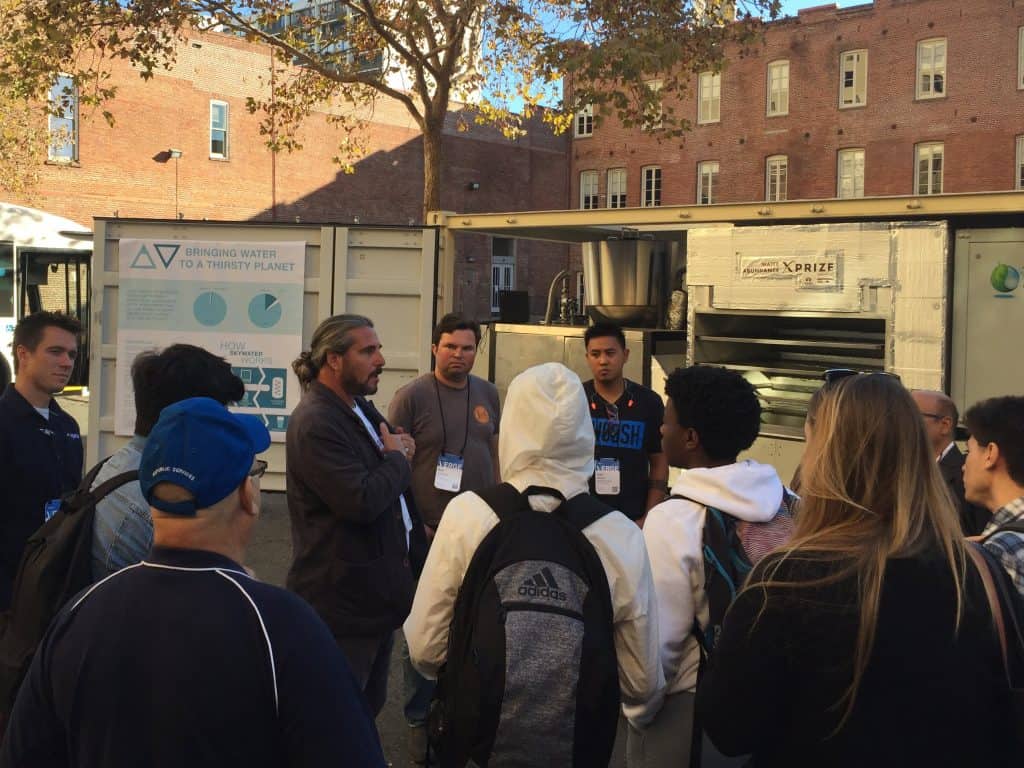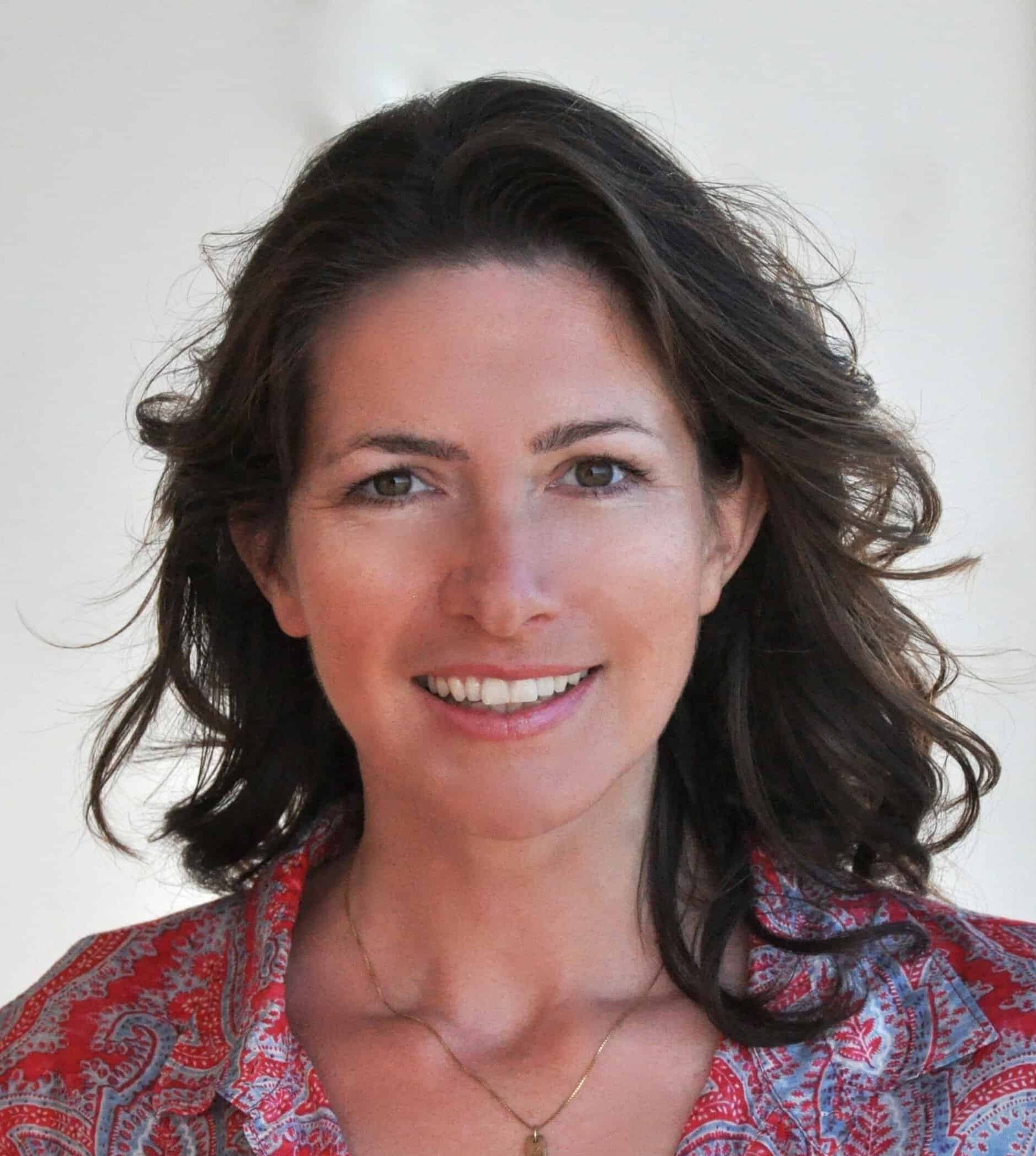The metal box behind the architectural offices of David Hertz in Venice, California, could easily be overlooked were it not covered in vibrant abstract art. Before the pandemic, the homeless could help themselves to free drinking water from the box; it also provides water to Hertz’s Studio of Environmental Architecture (S.E.A.) and more than 80 vegetable patches in the community garden around the corner.
But look closely, and you’ll notice that this water source is not connected to a pipeline. The drinking water it disburses comes from the sky, nearly 600 liters per day. “Did you know that at any given time, the atmosphere contains six times more water than all the rivers on the planet together?” Hertz asks. “The most important source for drinking water is all around us — the air that we breathe. So the question is: How do we harvest this?”
Hertz, 61, has been a pioneer of environmental architecture for nearly four decades. He apprenticed in the offices of architecture icons John Lautner and Frank Gehry before founding his own firm. Decades before it became fashionable, he designed sustainable houses. He has built a roof out of the wings of a Boeing 747, and the floor of a record label’s office from smashed vinyl records. Jovial and boyish, Hertz is particularly interested in “buildings that give back more to the environment than they take. We’ve already accomplished that with energy, but not yet with water.” That’s why, when he heard about innovative methods to collect water from the atmosphere, he was all ears.
Hertz explains how the process is based on condensation: When hot air touches a cool surface, atmospheric humidity condenses. The Skysource boxes can be heated up with either solar power or biomass. Even in drought-stricken California, each box can easily produce over 2,000 liters per day, more water than the architecture studio and nearby gardens can consume. Time Magazine named it one of the best inventions of 2020.
Hertz’s device may be modern, but the basic idea is ancient. Cultures like the Incas sustained their civilizations by collecting dew and installing fog fences. These traditional, passive methods are still being used today in some areas. Even arid desert air contains up to 40 percent humidity, especially at night. Desert plants slake their thirst by tapping this natural humidity, too.
But if the methods are ancient, the need is more urgent than ever. According to the WHO, one in three people globally don’t have access to safe drinking water. By 2025, half of the world’s population will be living in water-stressed areas.
Hertz and his wife Laura Doss-Hertz first made headlines with their idea in 2019 when Skysource won the $1.5 million Water Abundance XPrize. Out of 97 teams from 27 countries, only Skysource met the benchmarks set forth: produce at least 2,000 liters of clean water within 24 hours at a cost of fewer than two cents per liter using 100 percent renewable energy.

Skysource invested the prize money in creating an even more advanced iteration of its device: the “WeDew,” which stands for Wood-to-Energy Deployable Emergency Water. Powered by biomass like wood chips or walnut shells, the WeDew is indifferent to ambient weather conditions. “We are creating a tropical climate in the box,” Hertz explains. “We use whatever is abundant in the region. In Asia, it’s rice husks and coconut shells. In Africa, wood and [agricultural] waste. In California, we have plenty of dead and dying trees, and agricultural waste such as nut shells in abundance.”
The higher the humidity and the hotter the temperature, the more water can be harvested and filtered. “We are CO2-negative,” says Hertz, “meaning we sequester atmospheric carbon and turn it into biochar, a soil nutrient for regenerative agriculture.” WeDew runs on a small bio gasifier. “We don’t burn the biomass; we vaporize it into a gas that drives an engine, and we use the waste heat to generate water,” says Hertz. “You end up with high-density energy at about one-tenth of the space and cost of solar.”
The WeDew system can be optimized to generate not just water, but biochar, electricity, heat, or non-refrigerant-based cooling. A single device can produce up to 600 gallons of sanitary water per day, or 300 gallons plus electrical power. Hertz believes this makes it an effective solution for drought-stricken regions in Africa and Asia.
To this end, he uses small, discarded shipping containers to house the WeDew because they are cheap, practical and readily available in many countries. Hertz is currently partnering with the UN World Food Programme to bring his device to Uganda, Liberia and India. It can also be rapidly deployed for disaster relief. “The WeDew offers self-reliance and climate resilience, as the units are mobile,” Hertz says. “They enable people to be more independent and less vulnerable than with a single, large, central infrastructure.”
Crushed by negative news?
Sign up for the Reasons to be Cheerful newsletter.Since the pandemic began, Skysource has been working more locally. The Hertzes water their two farms and coffee plantation near Malibu with WeDew. CalFire has ordered several WeDew containers to fight wildfires — surprisingly, not with the water they produce, but with the biochar, which acts as a fire-retardant in soil. “Think of it as sky carbon. You’re taking atmospheric carbon vapor and turning it into a solid, useful product for soil revitalization, compost acceleration and regenerative agriculture,” Hertz explains. “It’s a fully circular system.”
The Hertzes aren’t the only ones working to improve atmospheric drinking water devices. The Incas’ high-tech successors at MIT have developed a solar-powered device that can extract drinkable water from the air even in dry regions. Researchers at the University of Texas have pioneered an atmospheric water generator (AWG) based on a hydrogel. And the U.S. military has a program called Atmospheric Water Extraction to provide water for soldiers on deployment. General Electric is currently improving the military device with the help of UC Berkeley chemist Omar Yaghi, who has developed highly porous crystal-like substances that bind water.
Many of these solar-powered systems are designed for arid regions and deserts. But the technology is increasingly used in drought-stricken parts of the U.S. Washington State-based Tsunami Products and the Israeli company Watergen have become pioneers that market directly to consumers in drought-stricken areas. When Mendocino, an idyllic town on the Northern Californian coast, saw a quarter of its 420 wells go dry due to drought, some residents purchased AWG devices.
But not everyone can — current models range from $30,000 to $200,000, depending on size and technology. This is why the early adopters have mostly been the mega-rich — for instance, Snap co-founder Evan Spiegel and his wife, model Miranda Kerr, who installed a box in their eco-conscious Malibu house where it provides enough water for the entire residence, the pool and a waterfall.
With grants, the technology is reaching the less wealthy, too. The Navajo Nation, where 40 percent of households live without running water, recently installed hydro panels that absorb water vapor and can each produce three to five liters per day. Californian Farms in Petaluma, Sonoma and Mendocino have installed WeDew for water and energy. The California Energy Commission sponsored an analysis that tested WeDew in a California neighborhood and confirmed it can not only make water, but also heat and cool a building while sequestering carbon in a virtuous cycle.
For Hertz himself, the technology turned out to be a lifesaver. When the devastating Woolsey Fire swept through Southern California in 2018, it destroyed more than 1,600 buildings. One might have been Hertz’s farm, which he rushed home to save. Luckily, he had enough water to keep the flames at bay.






